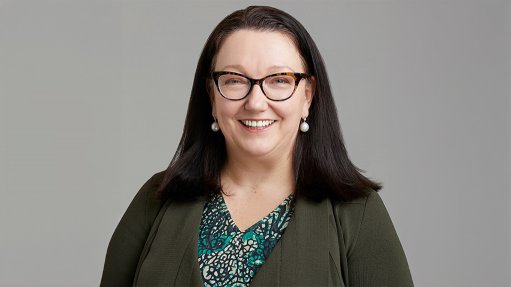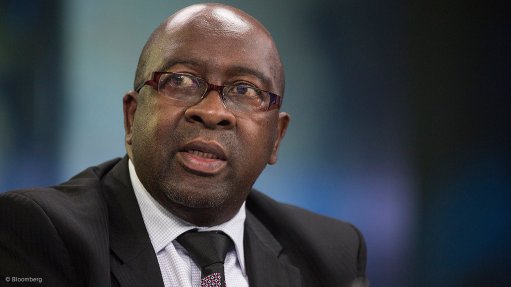More green hydrogen insight on way as Southern African scientists head to Germany

Sasscal Executive Director Dr Jane Olwoch interviewed by Mining Weekly's Martin Creamer. Video: Darlene Creamer.
JOHANNESBURG (miningweekly.com) – Twelve scientists from Southern African Development Community (SADC) countries will head to Germany in May, where they will have an opportunity to obtain more in-depth insight into green hydrogen amid the region’s unveiling of important green hydrogen projects, pilot plant initiatives and the awarding of a large number of green hydrogen scholarships.
Prominent this week during the Sasscal-organised two-day Green Hydrogen Symposium in Namibia was Sasscal executive director Dr Jane Olwoch, who emphasised to Engineering News & Mining Weekly in a Zoom interview that “the countries of Southern Africa should first and foremost take note of the region’s advantages of participating in the green hydrogen economy”. (Also watch attached Creamer Media video.)
"History is in the making and I’m very glad we’re part of it," added Olwoch.
Sasscal is SADC's science service centre for climate change and adaptive land management.
The symposium for the participating countries, such as Angola, Botswana, Democratic Republic of Congo, Eswatini, Malawi, Mauritius, Mozambique, Namibia, South Africa, Tanzania, Zambia and Zimbabwe, accentuated green hydrogen practice, fast-advancing pilot plants and far-reaching skills development to support Southern Africa’s green hydrogen thrust.
In addition to the dozen selected scientists, Olwoch announced that the first cohort of students would be leaving for Germany immediately after the symposium, with others following later.
Moreover, the symposium itself brought together representatives from industry, universities, governments and adolescents to witness the green hydrogen journey that Sasscal has been coordinating.
“The price of green hydrogen is on its way to becoming affordable,” said Olwoch, reaffirming its status as being more sustainable than any other energy on offer.
Mining Weekly: What is the present state of green hydrogen development in the SADC region?
Olwoch: Here in Namibia, there are projects on the ground that are going to produce green hydrogen in the next few years. One of these that is advancing really well is the Daures Green Hydrogen Village pilot project, which is 100% funded by the German Federal Ministry of Education and Research. All the preparatory steps have been taken. Its development is progressing in the desert of Namibia, where borehole water and equipment are opening the way for the generation of green hydrogen. Electrolysers have been imported and green ammonia will also be produced from what could be our first green hydrogen project. In addition, we'll have a refuelling station and the hope is that the green hydrogen from this will be transported to enable others to use it for many applications. We have also taken capacity building into consideration and young Namibians are taking charge of these projects as part of a really amazing story of cooperation between Germany and Namibia.
What is the level of skills development being generated by your Youth for Green Hydrogen scholarship initiative?
Once again, this is fully funded by Germany’s Federal Ministry of Education and Research and it sponsors the entry of young Namibians, between the ages of 18 and 35, into the field of green hydrogen development. There are already about 160 young Namibians in this programme. Last year, scholarships were awarded to 70 young students, 49 of them with master's degrees, and the rest with vocational qualifications. This year, for another 90, we'll reverse the order. Instead of a majority of master's graduates, most will be from the value chain, be it production, transportation, safety, welding, solar, mechanics and desalination. An advantage is that they’ll also spend six months at a German institution. These students are from and for the SADC as a whole and they’ll be available for employment in the next two years to ensure green hydrogen sustainability in our region. It’s a very good programme and we’re very grateful to Germany’s Federal Ministry of Education and Research.
What is it about renewable energy and green hydrogen that so important for the African continent?
We always tell ourselves that Africa is not a big emitter and yet when climate change strikes, the continent suffers floods and droughts in particular. So, yes, Africa is heavily affected by climate change and we must take responsibility, adapt and contribute to the reduction of greenhouse gases. But combatting of climate change also presents opportunity, as green hydrogen is doing by presenting new industrial and commercial prospects for the transition to cleaner energy. Green hydrogen provides the opportunity for countries to clean up the environment, restore ecosystems and to provide jobs, technology and new skills for the future.
When will green hydrogen become economically competitive?
It's almost there. Starting phases invariably take a bit longer because of the need to educate, research and prepare our countries to be able to implement the green economy. It is also important to know that our countries are positioning themselves to take advantage of the renewable energy resources at their disposal. We’ve done the research, we’re building the capacity and now the policies and regulatory frameworks must kick in. I'm very happy to say that our countries are strategically on track. We’re close to implementation, which we must ensure is done well. We want to produce the green hydrogen that will be most economically attractive to ourselves and to the world.
Why is it so regionally critical for Southern Africa that the world adopts platinum-based PEM electrolysers and platinum-based PEM fuel cells that are green hydrogen-driven?
This is critical because it is so crucial for the region to bring in the other resources that we have. Platinum is extremely important. We are not only going to be producing green hydrogen, but we are also going to be using natural resources to produce products domestically for export to other countries, and there are many options open to us.
What should be the biggest takeaway from all this?
The biggest takeaway should be that our countries must give research a chance before they invest a lot of resources into commercial production of green hydrogen. There is a lot we don't know about green hydrogen safety and transportation. Also, South Africa and Namibia need to know more about desalination of sea water. So, I'm saying do more research and skill our people so that we can sustain the green hydrogen economy.
GREEN HYDROGEN ATLAS
The datasets for the SADC green hydrogen atlas have been collected, and there are clear signs of the cost of Southern Africa’s green hydrogen being attractively low.
SADC’s green hydrogen hot spots have been identified where zero-carbon green hydrogen can be generated by using renewable energy to separate water into hydrogen and oxygen, with sea water the predominant water targeted.
H2Atlas-Africa was the first phase of German Federal Ministry of Education and Research’s ‘Go Green Go Africa Hydrogen’ initiative, involving the building of pilot plants to demonstrate SADC’s green hydrogen potential and competitiveness ahead of commercialisation. The work included mathematical modelling from Germany’s Forschungszentrum Jülich research institution.
PLATINUM GROUP METALS
The current global focus on green hydrogen as the next universal energy carrier has served to highlight the value of Southern Africa’s huge platinum group metals (PGMs) endowment, which goes hand-in-hand with the green hydrogen economy, both in terms of the PGM metals used in the electrolysers that produce green hydrogen, but also in terms of the platinum used in the hydrogen fuel cells that provide mobility, stationary power generation and heating in a very wide range of industrial, agricultural, commercial and residential applications. Platinum could see considerable demand from the green hydrogen sector, the World Platinum Investment Council has estimated.
SOUTH AFRICAN TEAM
South Africa’s national green hydrogen team structure was reported by Engineering News & Mining Weekly in September 2020 to be made up of people including:
Dr Rebecca Maserumule, chief director: hydrogen and energy, Department of Science and Innovation (DSI);
Professor Timothy Dube of the University of the Western Cape;
Dr Darija Susac, research and technology development manager for fuel cells and electrolysers and key programme manager, Hydrogen South Africa (HySA) Catalysis, DSI Centre of Competency, University of Cape Town;
Crescent Mushwana, Energy Systems, Council for Scientific and Industrial Research (CSIR) Energy Centre;
Dr Minesh Bipath of the South African National Energy Development Institute, who is leading the hydrogen road map work for South Africa;
Nomthandazo Mabena of the CSIR, who is working in battery storage technologies and fuel cells;
Thomas Roos, a senior CSIR researcher, who has been leading CSIR work on green hydrogen export opportunities for South Africa; and
Dr Dmitri Bessarabov of North-West University, who leads HySA Infrastructure in South Africa, under the DSI.
“The green hydrogen export market potential is much larger than the local green electricity market,” Roos stated in the Hydrogen, Fuel Cells & the Green Economy feature some time back in Engineering News & Mining Weekly.
“Renewable projects built for hydrogen production might even be a way for South Africa to subsidise the strengthening of its physical transmission grid, reducing the cost to the fiscus or existing electricity consumers,” Roos added.
At the same time, Bessarabov stated: “Water electrolysis can be used to produce hydrogen gas on a large scale. This hydrogen can be stored in different forms and subsequently used in various sectors.”
HySA Infrastructure is leading research and development efforts in South Africa in water electrolysis, based on PEM electrolysis technology, in which deionised water is split into hydrogen and oxygen on the application of an electric current.
Oxygen and protons are generated at the anode that contains iridium-based electrocatalyst. Iridium is a PGM. At the cathode, the protons that pass through the PEM are reduced by electrons to form hydrogen gas at a platinum-based electrocatalyst.
“Given the fact that the global water volume is estimated to be around 1.4 × 109 km3, hydrogen could be seen as an almost everlasting resource,” Bessarabov noted.
Venture capital company AP Ventures sees renewable energy-rich South Africa as having the potential to be a leading global source of low-cost green hydrogen, which offers the significant economic opportunity to create a long-lasting sustainable industry powered by PGMs, both domestically and internationally.
Hydrogen has the capacity to provide domestic energy resilience, new high-technology jobs and a tangible decarbonisation route, at residential and industrial levels.
“Hydrogen offers the opportunity to unlock investment into South Africa and create employment plus a competitive export market. Liquid organic hydrogen carrier technology is a key enabler to link the potential of South African low-cost green hydrogen production, both with domestic demand and to international markets. Recognising this valuable opportunity, we and our investors are working to make the hydrogen economy a reality both in South Africa and worldwide,” stated AP Ventures, the investors in which are the Public Investment Corporation of South Africa, Anglo American Platinum, Mitsubishi Corporation, the Toyota-linked Mirai Creation Fund and Plastic Omnium.
Comments
Press Office
Announcements
What's On
Subscribe to improve your user experience...
Option 1 (equivalent of R125 a month):
Receive a weekly copy of Creamer Media's Engineering News & Mining Weekly magazine
(print copy for those in South Africa and e-magazine for those outside of South Africa)
Receive daily email newsletters
Access to full search results
Access archive of magazine back copies
Access to Projects in Progress
Access to ONE Research Report of your choice in PDF format
Option 2 (equivalent of R375 a month):
All benefits from Option 1
PLUS
Access to Creamer Media's Research Channel Africa for ALL Research Reports, in PDF format, on various industrial and mining sectors
including Electricity; Water; Energy Transition; Hydrogen; Roads, Rail and Ports; Coal; Gold; Platinum; Battery Metals; etc.
Already a subscriber?
Forgotten your password?
Receive weekly copy of Creamer Media's Engineering News & Mining Weekly magazine (print copy for those in South Africa and e-magazine for those outside of South Africa)
➕
Recieve daily email newsletters
➕
Access to full search results
➕
Access archive of magazine back copies
➕
Access to Projects in Progress
➕
Access to ONE Research Report of your choice in PDF format
RESEARCH CHANNEL AFRICA
R4500 (equivalent of R375 a month)
SUBSCRIBEAll benefits from Option 1
➕
Access to Creamer Media's Research Channel Africa for ALL Research Reports on various industrial and mining sectors, in PDF format, including on:
Electricity
➕
Water
➕
Energy Transition
➕
Hydrogen
➕
Roads, Rail and Ports
➕
Coal
➕
Gold
➕
Platinum
➕
Battery Metals
➕
etc.
Receive all benefits from Option 1 or Option 2 delivered to numerous people at your company
➕
Multiple User names and Passwords for simultaneous log-ins
➕
Intranet integration access to all in your organisation



















